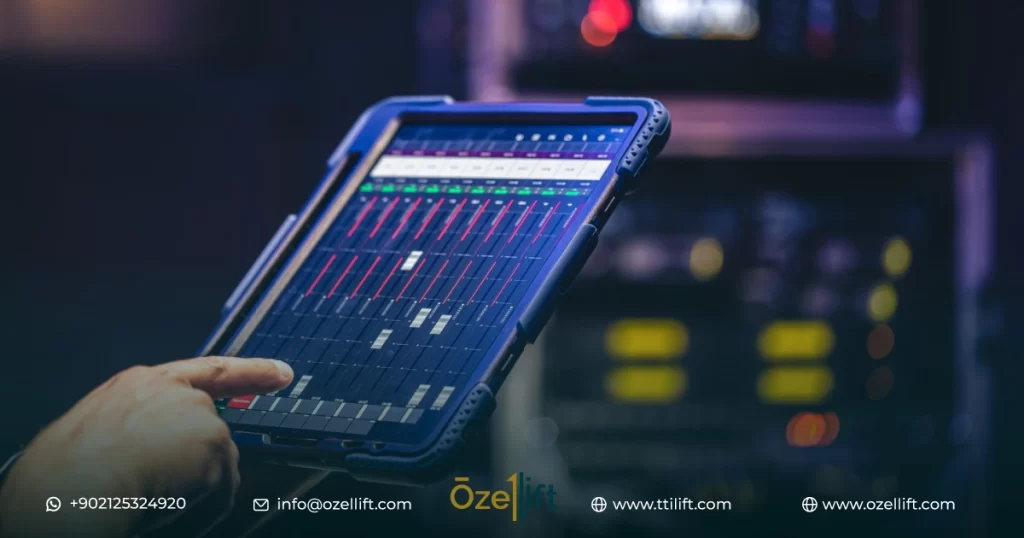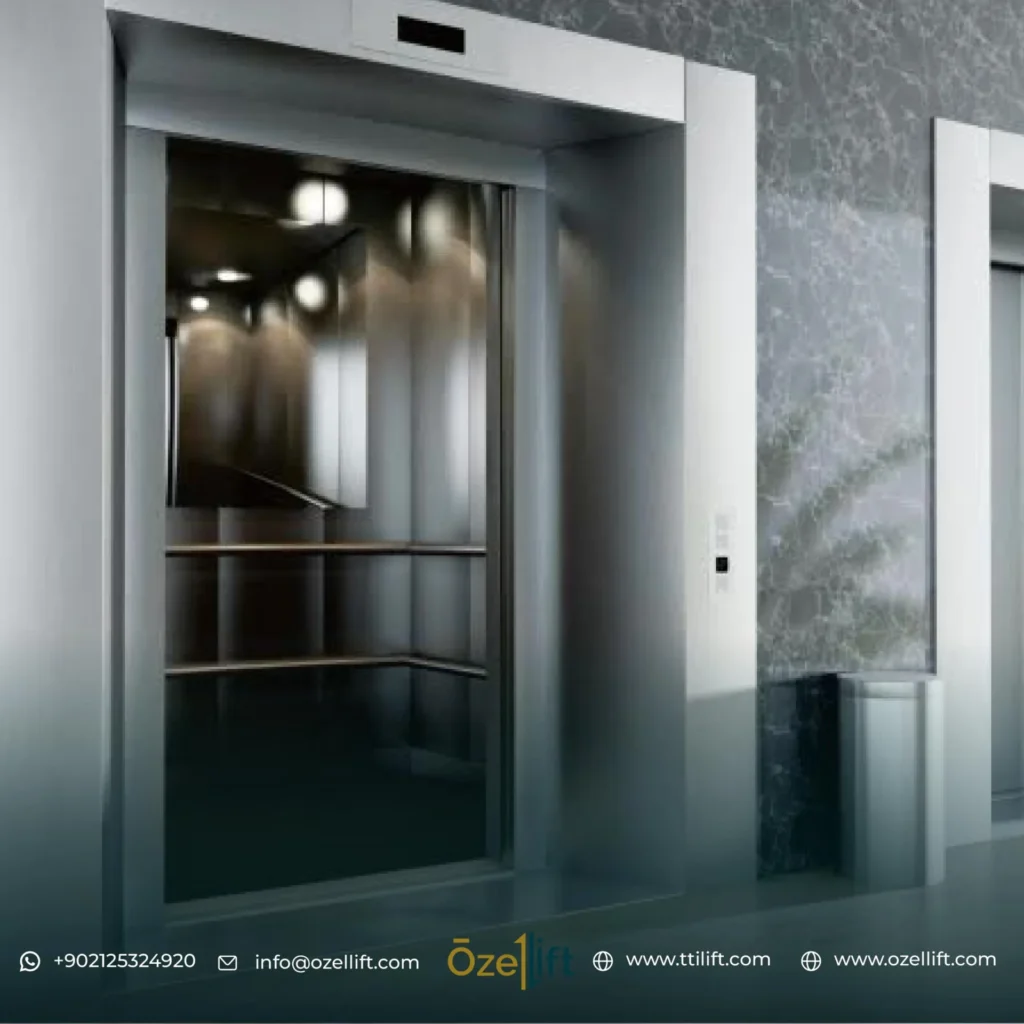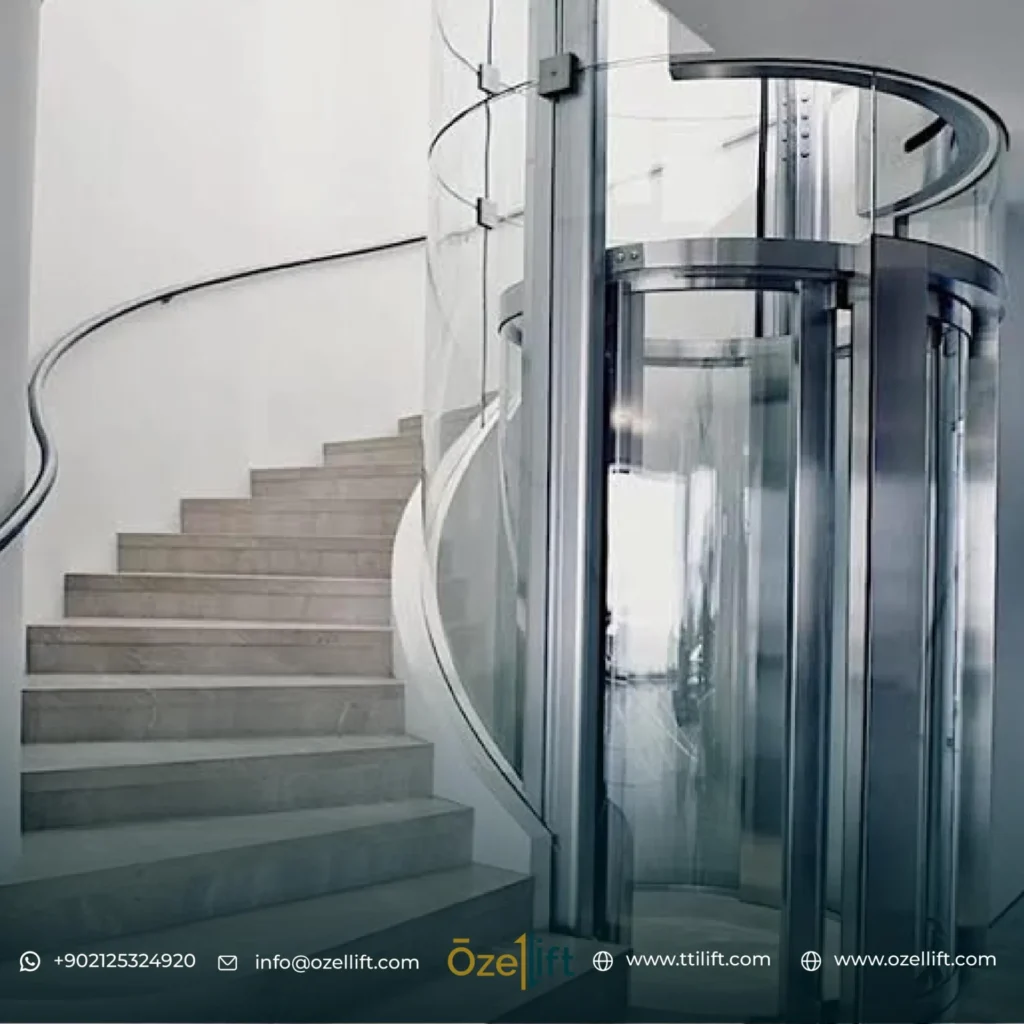Elevator control panels and machines are like the masterminds running these amazing rides. Through the control panels, we issue commands, while the machines operate the elevator and keep it moving smoothly and safely.
What is the importance of these components? What are the most important control panels and machines that must be available in the elevator? If you want to know more about these vital components, follow us in this article.
Elevators and their types
An elevator is a mechanical or hydraulic device used to move people and goods between floors of buildings.
Types of elevators
There are many types of elevators used in our world today. Elevators are classified as follows:
Depending on the installation method
- Internal elevators: installed inside the building.
- External elevators: installed on the facade of the building.
Depending on the type of movement
- Traction elevators: rely on a cable and pulley system.
- Hydraulic elevators: depend on the force of hydraulic pressure.
According to usage
- Passenger elevators: for transporting people.
- Freight elevators: for transporting goods.
- Car lifts: for transporting cars.
- Patient elevators: designated for transporting patients in hospitals.
Elevators are one of the most significant innovations that have contributed to changing our way of life. They constitute an important element in modern buildings, and provide a safe and comfortable way to move between floors, but in order for them to work correctly, it is necessary to ensure the safety of the control panels and machines.
The importance of control panels and machines in the operation of elevators
In this paragraph, let us mention the importance of control panels and machines in some detail.
The importance of control panels
- It issues commands and controls the direction and speed of the elevator.
- Shows information about the elevator’s location and destination.
- Enables communication with emergency services in emergency situations.
- monitors safety systems and activates them when needed.
The importance of machines
- It is the driving force that moves the elevator.
- maintains elevator stability and balance.
- Reduces noise and vibrations.
- It saves energy and reduces operating costs.
Examples of the importance of control panels and machines
- Modern control panels allow users to control the elevator using their smartphones.
- Modern machines are used to save energy and reduce carbon emissions.
- Modern safety systems prevent the elevator from falling or colliding with anything.
Control panels and machines play an important role in the operation of elevators. Through cooperation between these components, elevators have become a safe and comfortable way to move between floors of buildings. Without control panels and machines, elevators will not work, so it is important to ensure that they are maintained regularly to ensure their proper and safe operation.
Elevator control panels
What are control panels? How does it work? What are its most important functions? Let’s get to know each other.
The control panel is the elevator’s user interface. It is a set of buttons and screens that allow users to interact with the elevator and issue commands to it.
Control panel functions
Issuing commands: The control panel is used to issue commands to the elevator such as:
- Choose the floor you want to reach.
- Opening and closing elevator doors.
- Stop the elevator in emergency situations.
- Show information: The control panel shows information about:
- Elevator location.
- Elevator destination.
- Elevator status (running, stopped, etc.).
- Communicating with emergency services: Some control panels allow communication with emergency services in emergency situations.
- Monitoring safety systems: Some control panels monitor safety systems and activate them when needed.
Types of control panels
- Traditional control panels: used in old elevators, and consist of simple buttons to display floors.
- Modern control panels: used in modern elevators, and have many advantages such as:
- Touch screens: allow users to interact with the elevator more easily.
- Facial recognition system: allows users to reach the desired floor without having to press any button.
- GPS: Locates the elevator in real time.
Maintenance of control panels
It is important to ensure that control panels are maintained regularly to ensure they operate properly and safely.
Control panels play an important role in the operation of elevators. Through cooperation between control panels and machines, elevators become a safe and comfortable way to move between floors of buildings.
Control panel components
The most important components of control panels are the following:
1. Control buttons:
The control buttons are used to select the floor to be accessed, open and close the elevator doors, and stop the elevator in emergency situations.
2. Display screens:
The displays show information about the elevator’s location, destination, and status (running, stopped, etc.).
3. Safety systems:
Safety systems monitor the elevator and operate them when needed, such as:
- Fall prevention system: It prevents the elevator from falling in the event of a power outage or any malfunction.
- Collision prevention system: Prevents the elevator from colliding with anything.
- Alarm system: Alerts users in emergency situations.
- other ingredients:
- Electronic circuit board: Powers all components of the elevator.
- Sensors: monitor the elevator’s movement and location.
- Cables: Used to transmit power and signals between elevator components.
Elevator Cabin Operating Panels (COPs)
Elevator Cabin Operating Panels (COPs) are the brains behind those smooth and safe rides between floors. These panels allow users to interact with the elevator and give it instructions.
Here’s a closer look at the different components of a typical COP:
Buttons
- Floor selection buttons: These are the most prominent buttons, typically arranged in a vertical row corresponding to the building’s floors. They allow users to choose their desired destination.
- Direction buttons: These buttons, usually arrows pointing up and down, indicate whether the user wants to go to a higher or lower floor.
- Other buttons: Depending on the elevator model and features, additional buttons might be present, such as:
- Door open/close: To manually control the opening and closing of the elevator doors.
- Alarm: To alert building security or maintenance in case of emergencies.
- Intercom: To communicate with building personnel outside the elevator.
- Accessibility features: Buttons for Braille labeling, emergency lowering, or specific floor access for disabled individuals.
Display
- Floor indicator: Shows the current floor the elevator is on.
- Direction indicator: Indicates the direction the elevator is moving (up or down).
- Additional information: Depending on the model, the display might show overload warnings, estimated arrival time, or even news and weather updates.
Emergency features
- Emergency stop button: Immediately stops the elevator and opens the doors in case of emergencies.
- Emergency phone: Allows direct communication with building security or emergency services.
Modern COPs
Modern elevator COPs are increasingly incorporating advanced features for enhanced user experience and accessibility. These include:
- Touchscreen interfaces: Replacing physical buttons with a more intuitive and interactive screen for selecting floors and accessing options.
- Voice control: Enabling hands-free operation by allowing users to voice their desired floor or command.
- Mobile app integration: Controlling the elevator through a smartphone app, potentially calling it in advance or selecting a floor before entering.
- Biometric authentication: Using fingerprint or facial recognition for secure access to specific floors.
By combining these elements, elevator COPs play a crucial role in ensuring a safe, convenient, and accessible experience for everyone using elevators.
Know more about
Elevator flooringing
Elevator doors
Elevator machines
Elevator machinery is a set of mechanical and electrical components that are used to operate an elevator.
Elevator machinery functions
- Moving the elevator: Machines are used to move the elevator up and down.
- Stopping the elevator: Machines are used to stop the elevator at the desired floor.
- Opening and closing elevator doors: Machines are used to open and close elevator doors.
- Maintaining elevator stability: Machines are used to maintain elevator stability and prevent it from shaking.
- Energy saving: Modern machines are used to save energy and reduce carbon emissions.
Types of machines
The most important types of machines used in elevators are the following:
Elevator motors
Elevator motors are used to move the elevator up and down.
Types of elevator motors
- Traction motors: used in most elevators.
- Gearless motors: used in high-speed elevators.
- Hydraulic motors: used in some low capacity elevators.
Gear systems
Gear systems are used to change the rotational speed of the elevator motor.
Types of gear systems
- Helical gear systems: used in most elevators.
- Planetary gear systems: used in some high-speed elevators.
Braking systems
Brake systems are used to stop the elevator at the desired floor.
Types of braking systems
- Electromagnetic ballasts: used in most elevators.
- Hydraulic brakes: used in some low capacity elevators.
Balance systems
Balancing systems are used to keep the elevator stable and prevent it from shaking.
Types of balance systems
- Static balancing systems: used in most elevators.
- Dynamic balancing systems: used in some high-speed elevators.
other ingredients
- Power Generators: Used to provide power to the elevator.
- Cooling systems: used to keep the elevator cool.
- Lighting systems: used to illuminate the elevator.
There is no doubt that machines and equipment may differ from one elevator to another, but they all play an important role in the operation of elevators, and constitute an important part of ensuring their proper and safe operation.
Modern technologies in elevator machines
Modern technologies in elevator machines:
The field of elevator technologies is witnessing continuous development, which contributes to improving the efficiency, safety and comfort of their use. Among the most important modern technologies in elevator machines are:
1. Permanent magnet motors:
- Provides higher energy efficiency than conventional traction motors.
- Reduces noise and vibrations.
- Reduces operating and maintenance costs.
2. Intelligent control systems:
- It allows the elevator to be controlled via a smartphone.
- Improves energy efficiency.
- Reduces waiting time.
- Provides information about the elevator’s status and location.
3. Advanced safety systems:
- Provides systems to prevent falls and collisions.
- The condition of the elevator is monitored continuously.
- Provides advanced alarm systems.
4. Energy saving technologies:
- Energy efficient lighting systems are used.
- Energy recycling systems are used.
- Elevator speed control systems are used.
5. Other smart technologies:
- Facial recognition systems are used to determine the user’s destination.
- GPS systems are used to determine the location of the elevator in real time.
- Data analysis systems are used to improve the operating efficiency of elevators.
Benefits of using modern technologies in elevator machines
There is no doubt that the use of modern technologies in elevator machines improves the user experience by:
- Improve energy efficiency.
- Improve safety and comfort.
- Reducing operating and maintenance costs.
Modern technologies contribute to making elevators more efficient, safe and comfortable, and as technology develops, we expect to see more innovative technologies in the field of elevators in the future.
Safety systems in elevators
Safety systems in elevators are an essential element in ensuring the safety of their users, as they help prevent accidents and injuries.
The importance of safety systems
- Helps prevent accidents and injuries.
- Provides a feeling of security and comfort to users.
- Reduces insurance costs.
- Improves the reputation of the building.
Types of safety systems
There are many types of safety systems that must be available in the elevator and to ensure the quality of their work, the most important of which are:
Fall protection systems
- Bumper system: used at the bottom of the elevator shaft to prevent the cabin from falling in case the brake system fails.
- Brake system: used to stop the elevator if the traction system fails.
- Free Fall Prevention System: Used to prevent the cab from falling free if all other safety systems fail.
Collision protection systems
- Light barrier system: used to prevent the cabin from hitting anything in the elevator shaft.
- Mechanical barrier system: used to prevent the cabin from hitting anything in the elevator shaft.
- Speed control system: It is used to control the speed of the elevator and prevent it from colliding with anything.
Alarm systems
- Fire alarm system: used to warn of the presence of a fire in the building.
- Power outage alarm system: used to warn of power outages.
- Emergency Alarm System: Used to warn of a threat to users’ safety.
In addition to these types, there are many other safety systems that are used in elevators, such as:
- Door monitoring system: used to ensure that all elevator doors are closed safely before it moves.
- Load monitoring system: used to ensure that the elevator is not loaded beyond its carrying capacity.
- Emergency Communication System: Used to communicate with emergency services in emergency situations.
- In conclusion:
Safety systems in elevators are an essential element in ensuring the safety of their users, and through cooperation between building owners and users, we can ensure the safe use of elevators and avoid any accidents.
Know more about
Modern technologies in safety systems
The field of safety technologies in elevators is constantly evolving, which contributes to improving the efficiency, safety and comfort of their use.
Among the most important modern technologies in safety systems:
1. Intelligent fault detection systems:
Artificial intelligence technologies are used to analyze operating data and predict malfunctions before they occur. These systems allow preventive maintenance to be performed before malfunctions occur, which helps prevent accidents.
2. Intelligent control systems:
It allows the elevator to be controlled via a smartphone, continuously monitors the status of the elevator, and sends notifications to users in the event of any malfunction.
3. Networking systems:
They are used to connect elevators to other systems in a building, such as firefighting and lighting systems, and allow all building systems to be coordinated to improve safety.
4. Augmented reality systems:
Used to provide information to users about the status and location of the elevator, these systems help users use the elevator more conveniently and safely.
Modern technologies contribute to making elevators safer and more comfortable. With the development of technology, we expect to see more innovative technologies in the field of elevator safety systems in the future.
Maintenance of control panels and machines
Maintenance of control panels and machines is essential to ensure the safety of the elevator and its users. Below we review the most important points for maintenance.
The importance of regular maintenance
- Helps ensure the safety of elevator users.
- Extends the life of control panels and machines.
- Reduces operating and maintenance costs.
- Improves the efficiency of elevators.
Steps for maintaining control panels and machines
- Check all components periodically.
- Clean all components from dust and dirt.
- Conduct operational tests to ensure all components are working properly.
- Replace any damaged or malfunctioning components.
- Record all maintenance work in a special register.
Signs of malfunction in control panels and machines
- The elevator stopped working.
- The elevator moved irregularly.
- Abnormal sounds coming from the elevator.
- Error messages appear on the control panel.
- Power outage in the elevator.
If any of these signs appear, you must contact a specialized maintenance company to deal with the malfunction.
Tips for maintaining control panels and machines
Regular maintenance must be performed by specialized technicians. Original spare parts must be used in the repair process, and maintenance records must be kept in a safe place.
In conclusion:
Regular maintenance of control panels and machines is an essential element to ensure the safety and efficiency of elevator operation. By following regular maintenance steps and using modern technologies, we can ensure the safety of elevator users and avoid any accidents.
Özellıft Company – the best for purchasing and maintaining control panels and machines
Özellıft is a leading company in the field of manufacturing and maintaining control panels and machinery for elevators. The company was founded in Turkey, and has extensive experience in this field. Özellıft offers a wide range of products and services, including:
- Control panels for elevators of all types.
- Elevator machines of all capacities.
- Original spare parts for elevators.
- Regular maintenance services for elevators.
- Elevator repair services.
Özellıft has many advantages, including:
- High quality products.
- Excellent services.
- Competitive prices.
- Extensive experience in the field of elevators.
- A specialized and trained work team.
If you are looking for a company to purchase or maintain control panels and machines for elevators, Özellıft is the perfect choice – contact the company’s advisory team now and submit your questions so that they can answer them as quickly as possible.



